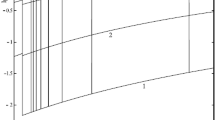Summary
It has been proposed in an earlier paper that photons can interact weakly with neutrinos. Assuming this photon-neutrino coupling, the effect of energy loss due to the pair-annihilation process and the photoneutrino process on the evolutionary time scales of a 15.6M ⊙ star has been discussed. In the typical model of Hayashi, Hoshi and Sugimoto (HHS), the lifetimes for carbon burning and later phases have been calculated assuming the photon-neutrino coupling, and is compared with the results obtained by HHS according to the (eν)(eν) coupling. In case of the\(\gamma \nu \bar \nu \) coupling, the ratio of the number of blue supergiants (He-burning stars) to red supergiants (stars in C-burning and later stages) is found to be ≲ 10 with the initial concentration of carbonX c=0.5, whereas according to the (eν)(eν) coupling, the corresponding ratio is found to be nearly 33. According to astrophysical observations, this ratio is found to be nearly unity within a factor 1.5. It is noted that the result according to the\(\gamma \nu \bar \nu \) coupling becomes significantly better in comparison with the (eν)(eν) coupling. Also, in view of the uncertatinties regarding the total luminosity in the red-supergiant phase as well as the rate of C+C relation, we can consider the result obtained according to the\(\gamma \nu \bar \nu \) coupling to be in reasonable proximity to the «observed» value. From this, we argue that stars seem to «favour» the photon-neutrino coupling theory rather than the current-current coupling theory of weak interactions.
Riassunto
Si è proposta, precedentemente, la possibilità di un’interazione debole dei fotoni con i neutrini. Supponendo valido l’accoppiamento fotone-neutrino, si è discusso l’effetto della perdita di energia sulle scale di tempo evolutivo di una stella di 15.6M ⊙. Col modello tipico di Hayashi, Hoshi e Sugimoto (HHS), si sono calcolate le vite medie della combustione del carbonio e delle fasi successive, nell’ipotesi di accoppiamento fotoneneutrino. Si è confrontato il risultato così ottenuto con quello ricavato da HHS secondo l’accoppiamento (eν)(eν). Nel caso di accoppiamento\(\gamma \nu \bar \nu \), si trova che il rapporto fra le stelle supergiganti blu (stelle a combustione di He) e quelle rosse (stelle a combustione di C ed in fasi successive) è ≲ 10, posto che la concentrazione iniziale di carbonio,X c, sia 0.5, mentre, nel caso di accoppiamento (eν)(eν), il suddetto rapporto risulta essere circa 33. Basandosi su osservazioni astrofisiche il rapporto è invece circa unitario entro un fattore di 1.5. Si constata che il valore ottenuto con l’accoppiamento\(\gamma \nu \bar \nu \) è migliore, e in modo significativo, del valore ottenuto con l’altro tipo di accoppiamento. Se si considera poi l’attuale incertezza, sia per quanto concerne la luminosità totale nella fase di super giganti rosse sia per quanto concerne il rapporto della relazione C+C, si può ritenere il risultato ottenuto con l’accoppiamento\(\gamma \nu \bar \nu \) come quello che più approssima il valore «osservato». Da tutto ciò segue che l’osservazione delle stelle sembra «favorire» la teoria dell’accoppiamento fotone-neutrino per le interazioni deboli, piuttosto che quella dell’accoppiamento corrente-corrente.
Реэюме
В предыдушей работе было предположено, что фотоны могут слабо вэаимодействовать с нейтрино. Предполагая зту фотон-нейтринную свяэь, было рассмотрено влияние потери знергии, обусловленной процессом аннигиляции пар и фото-нейтринным процессом, на зволюционные масщтабы времени для эвеэды 15.6M ⊙. В типичной модели Хайащи, Хопщ и Сугимото были вычислены времена жиэни для горения углерода и более поэдние фаэы, предполагая фотон-нейтринную свяэь. Полученные реэультаты сравниваются с реэультатами, полученными Хайащи, Хощи и Сугимото в соответствии с (eν)(eν) свяэью. В случае\(\gamma \nu \bar \nu \) свяэи получено, что отнощение числа голубых супергигантов (эвеэды с горением Не) к числу красных супергигантов (эвеэды в стадии горения С и более поэдних стадиях) составляет ≲10 с начальной концентрацией углеродаX c=0.5, в то время как в соответствии с (eν)(eν) свяэью, соответствуюшее отнощение приблиэительно равно 33. Найдено, что согласно астрофиэическим наблюдениям зто отнощение составляет приблиэительно единицу, в пределах множителя 1.5. Отмечается, что реэультат в соответствии с\(\gamma \nu \bar \nu \) свяэью становится эначительно лучще по сравнению с (eν)(eν) свяэью. Также, в виду неопределенностей относительно полной светимости в фаэе красного супергиганта, а также скорости C + C реакции, мы можем считать, что реэультат, полученный в соответствии с\(\gamma \nu \bar \nu \) свяэью, находится в раэумной области блиэости с « наблюдаемой » величиной. Иэ зтого мы утверждаем, что эвеэды, по-видимому, « отдают предпочтение » теории фотон-нейтринной свяэи по сравнению с теорией ток-токовой свяэи слабых вэqaимодействий.
Similar content being viewed by others
References
R. P. Feynman andM. Gell-Mann:Phys. Rev.,109, 193 (1958).
P. Bandyopadhyay:Phys. Rev.,173, 1481 (1968) (hereafter referred to as I).
P. Bandyopadhyay: preprint. The implications of the dynamical origin of charge in weak interactions in terms of the Sakata model for hadrons has been discussed in an earlier paper. See,P. Bandyopadhyay:Progr. Theor. Phys.,32, 810 (1964).
M. Gell-Mann:Phys. Rev. Lett.,6, 70 (1961).
C. Hayashi, R. Hoshi andD. Sugimoto:Progr. Theor. Phys., Suppl. 22 (1962).
H. Y. Chiu andP. Morrison:Phys. Rev. Lett.,5, 573 (1960).
H. Y. Chiu andR. Stabler:Phys. Rev.,122, 1317 (1961).
P. Bandyopadhyay andP. Ray Chaudhuri: Submitted for publication.
V. I. Ritus:Zurn. Eksp. Teor. Fiz.,41, 1285 (1961) (English translation:Sov. Phys. JETP,14, 915 (1962)).
M. Ida andM. Uehara: unpublished (reported by HHS in ref. (5)).
F. Hoyle andW. A. Fowler:Astrophys. Journ.,132, 565 (1960).
F. Hoyle:Month. Not. Roy. Astr. Soc.,106, 343 (1946).
H. Arp:Astron. Journ.,64, 254 (1959).
C. Hayashi andR. C. Cameron:Astrophys. Journ.,136, 166 (1962).
R. Stothers andC. W. Chin:Astrophys. Journ.,152, 225 (1968).
C. W. Chin, H. Y. Chiu andR. Stothers:Ann. of Phys.,39, 280 (1966).
P. Ray Chaudhuri:Ann. of Phys. (submitted for publication).
Author information
Authors and Affiliations
Additional information
To speed up publication, the author of this paper has agreed to not receive the proofs for correction.
Rights and permissions
About this article
Cite this article
Bandyopadhyay, P. Theories of weak interactions and astrophysical evidence. Nuov Cim A 1, 680–690 (1971). https://doi.org/10.1007/BF02734391
Received:
Published:
Issue Date:
DOI: https://doi.org/10.1007/BF02734391




